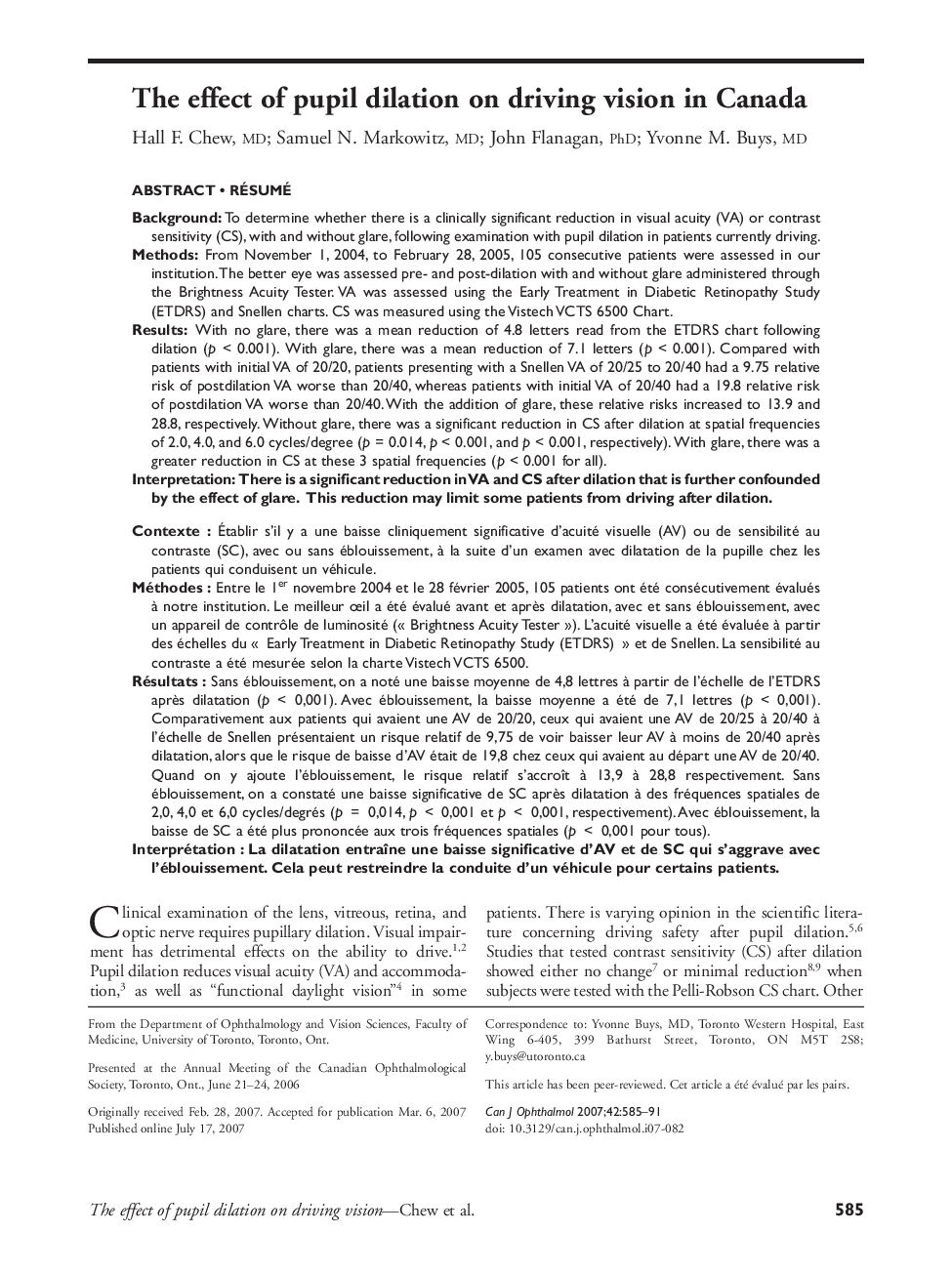| کد مقاله | کد نشریه | سال انتشار | مقاله انگلیسی | نسخه تمام متن |
|---|---|---|---|---|
| 4010934 | 1602449 | 2007 | 7 صفحه PDF | دانلود رایگان |

Background: To determine whether there is a clinically significant reduction in visual acuity (VA) or contrast sensitivity (CS), with and without glare, following examination with pupil dilation in patients currently driving.Methods: From November 1, 2004, to February 28, 2005, 105 consecutive patients were assessed in our institution.The better eye was assessed pre- and post-dilation with and without glare administered through the Brightness Acuity Tester. VA was assessed using the Early Treatment in Diabetic Retinopathy Study (ETDRS) and Snellen charts. CS was measured using the Vistech VCTS 6500 Chart.Results: With no glare, there was a mean reduction of 4.8 letters read from the ETDRS chart following dilation (p < 0.001). With glare, there was a mean reduction of 7.1 letters (p < 0.001). Compared with patients with initial VA of 20/20, patients presenting with a Snellen VA of 20/25 to 20/40 had a 9.75 relative risk of postdilation VA worse than 20/40, whereas patients with initial VA of 20/40 had a 19.8 relative risk of postdilation VA worse than 20/40. With the addition of glare, these relative risks increased to 13.9 and 28.8, respectively. Without glare, there was a significant reduction in CS after dilation at spatial frequencies of 2.0, 4.0, and 6.0 cycles/degree (p = 0.014, p < 0.001, and p < 0.001, respectively). With glare, there was a greater reduction in CS at these 3 spatial frequencies (p < 0.001 for all).Interpretation: There is a significant reduction in VA and CS after dilation that is further confounded by the effect of glare. This reduction may limit some patients from driving after dilation.
RésuméContexte: Établir s’il y a une baisse cliniquement significative d’acuité visuelle (AV) ou de sensibilité au contraste (SC), avec ou sans éblouissement, à la suite d’un examen avec dilatation de la pupille chez les patients qui conduisent un véhicule.Méthodes: Entre le 1er novembre 2004 et le 28 février 2005, 105 patients ont été consécutivement évalués à notre institution. Le meilleur œil a été évalué avant et après dilatation, avec et sans éblouissement, avec un appareil de contrôle de luminosité (« Brightness Acuity Tester «). L’acuité visuelle a été évaluée à partir des échelles du « Early Treatment in Diabetic Retinopathy Study (ETDRS) « et de Snellen. La sensibilité au contraste a été mesurée selon la charte Vistech VCTS 6500.Résultats: Sans éblouissement, on a noté une baisse moyenne de 4,8 lettres à partir de l’échelle de l’ETDRS après dilatation (p < 0,001). Avec éblouissement, la baisse moyenne a été de 7,1 lettres (p < 0,001). Comparativement aux patients qui avaient une AV de 20/20, ceux qui avaient une AV de 20/25 à 20/40 à l’échelle de Snellen présentaient un risque relatif de 9,75 de voir baisser leur AV à moins de 20/40 après dilatation, alors que le risque de baisse d’AV était de 19,8 chez ceux qui avaient au départ une AV de 20/40. Quand on y ajoute l’éblouissement, le risque relatif s’accroît à 13,9 à 28,8 respectivement. Sans éblouissement, on a constaté une baisse significative de SC après dilatation à des fréquences spatiales de 2,0,4,0 et 6,0 cycles/degrés (p = 0,014, p < 0,001 et p < 0,001, respectivement). Avec éblouissement, la baisse de SC a été plus prononcée aux trois fréquences spatiales (p < 0,001 pour tous).Interprétation: La dilatation entraîne une baisse significative d’AV et de SC qui s’aggrave avec l’éblouissement. Cela peut restreindre la conduite d’un véhicule pour certains patients.
Journal: Canadian Journal of Ophthalmology / Journal Canadien d'Ophtalmologie - Volume 42, Issue 4, August 2007, Pages 585-591